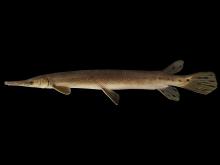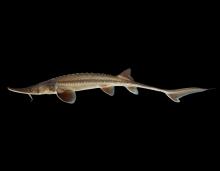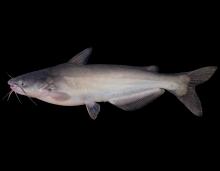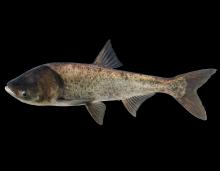Fishes
Media

Species Types
Scientific Name
Acipenser fulvescens
Description
The lake sturgeon is Missouri’s largest sturgeon and is rare and endangered in our state. Note its conical (not shovel-nosed) snout. Despite its name, in Missouri this fish is almost always found in big rivers, not lakes.
Media

Species Types
Scientific Name
Lepisosteus platostomus
Description
The shortnose gar is named for its relatively short, broad snout. Like other gars, it's a long, cylindrical fish with a long snout and numerous prominent teeth. The body is covered with hard, diamond-shaped scales.
Media

Species Types
Scientific Name
Scaphirhynchus albus
Description
The pallid sturgeon is federally and state endangered. This rarely found but widely distributed bottom dweller lives mostly in the Missouri and lower Mississippi rivers.
Media

Species Types
Scientific Name
Anguilla rostrata
Description
The American eel is considered an uncommon catch by Missouri sport anglers. This species is known to take natural baits and rarely takes artificial baits.
Media

Species Types
Scientific Name
Ictalurus furcatus
Description
The blue catfish is a big-river fish, preferring swift chutes, pools with noticeable current, and silt-free substrates. In Missouri, it's most common in the Mississippi, Missouri, and Osage rivers.
Media

Species Types
Scientific Name
Pylodictis olivaris
Description
The flathead catfish has a broad, flattened head with small eyes on top. The lower jaw projects beyond the upper jaw. It occurs in most of the large streams of Missouri, preferring places with a slow current.
Media

Species Types
Scientific Name
Esox lucius
Description
The largest pike native to Missouri, the northern pike can be more than 4 feet long and weigh more than 40 pounds. Missouri is on the southern edge of the range of this species. Because of its rarity here, it is of little importance as a game fish.
Media

Species Types
Scientific Name
Ctenopharyngodon idella
Description
Grass carp are large-bodied with a broad head and a terminal transverse mouth. The scales appear crosshatched. A native of east Asia, it is now widely distributed in the Missouri, Mississippi, and St. Francis rivers and in impoundments.
Media

Species Types
Scientific Name
Mylopharyngodon piceus
Description
The black carp is a large, invasive carp from Asia. It eats mussels and snails and can damage populations of native mollusks. It is illegal to transport live black carp across state lines.
Media

Species Types
Scientific Name
Hypophthalmichthys nobilis
Description
The bighead carp is an invasive Asian carp. It does not jump as frequently as its cousin the silver carp, but it also leaps from the water when disturbed, threatening boaters' safety.
See Also


Media

Species Types
Scientific Name
Amphiuma tridactylum
Description
The three-toed amphiuma is an eel-like, completely aquatic salamander. It has very small forelimbs and hind limbs, each with three tiny toes. In Missouri it’s found only in the Bootheel region.
Media

Species Types
Scientific Name
Siren intermedia nettingi
Description
The western lesser siren is an eel-like, aquatic salamander with external gills, small eyes, small forelimbs with four toes, and no hind limbs. In Missouri, it’s found mostly in the Bootheel and northward in counties near the Mississippi River.
About Fishes in Missouri
Missouri has more than 200 kinds of fish, more than are found in most neighboring states. Fishes live in water, breathe with gills, and have fins instead of legs. Most are covered with scales. Most fish in Missouri “look” like fish and could never be confused with anything else. True, lampreys and eels have snakelike bodies — but they also have fins and smooth, slimy skin, which snakes do not.





















